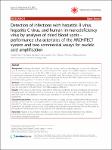Detection of infections with hepatitis B virus, hepatitis C virus, and human immunodeficiency virus by analyses of dried blood spots - performance characteristics of the ARCHITECT system and two commercial assays for nucleic acid amplification
Ross, Stefan
Stambouli, Oumaima
Grüner, Nico
Marcus, Ulrich
Cai, Wei
Zhang, Weidong
Zimmermann, Ruth
Roggendorf, Michael
Background: Nowadays, dried blood spots (DBS) are primarily used to obtain diagnostic access to risk collectives such as intravenous drug users, who are prone to infections with hepatitis B virus (HBV), hepatitis C virus (HCV), and human immunodeficiency virus (HIV). Before DBS analyses can be used in this diagnostic context, however, a comprehensive evaluation of its performance characteristics must be conducted. To the best of our knowledge, the current study presents for the first time such essential data for the Abbott ARCHITECT system, which is currently the worldwide leading platform in this field of infection diagnostics. Methods: The investigation comprised 1,762 paired serum/DBS samples and a total of 3,524 determinations with the Abbott ARCHITECT HBsAg, anti-HBc, anti-HBs, anti-HCV and HIV-1-p24-antigen/anti-HIV 1/2 assays as well as with the artus HBV LC PCR and VERSANT HCV RNA qualitative (TMA) tests. Results: In the context of DBS testing, a specificity of 100% was recorded for the seven serological and molecular biological assays. The analytical sensitivity of HBsAg, anti-HBc, anti-HBs, anti-HCV, HIV-1-p24-antigen/anti-HIV 1/2, HBV DNA, and HCV RNA detections in DBS eluates was 98.6%, 97.1%, 97.5%, 97.8%, 100%, 93%, and 100%, respectively. Discussion/conclusions: The results obtained indicate that it is today possible to reliably detect HBsAg, anti-HBc, anti-HBs, anti-HCV and HIV-1-p24 antigen/anti-HIV 1/2 with state-of-the-art analytical systems such as the Abbott ARCHITECT in DBS eluates even when a comparatively high elution volume of 1,000 μl is used. They also provide evidence for the inherent analytical limits of DBS testing, which primarily concern the anti-HBc/anti-HBs system for individuals with HIV infections and nucleic acid tests with relatively low analytical sensitivity.
No license information
Related Items
Show related Items with similar Title, Author, Creator or Subject.
-
2000-10-01ZeitschriftenartikelLebensmittelassoziierte Virusinfektionen Höhne, Marina; Schreier, EckartBis in die 70er Jahre war die Diagnostik von infektiösen Diarrhöen auf den Nachweis von Bakterien und Parasiten beschränkt, und auslösende Erreger konnten nur in einigen Fällen ermittelt werden. Verbesserte Nachweismethoden ...
-
2015-06-19ZeitschriftenartikelIn Silico Prediction and Experimental Confirmation of HA Residues Conferring Enhanced Human Receptor Specificity of H5N1 Influenza A Viruses Schmier, Sonja; Mostafa, Ahmed; Haarmann, Thomas; Bannert, Norbert; Ziebuhr, John; Veljkovic, Veljko; Dietrich, Ursula; Pleschka, StephanNewly emerging influenza A viruses (IAV) pose a major threat to human health by causing seasonal epidemics and/or pandemics, the latter often facilitated by the lack of pre-existing immunity in the general population. Early ...
-
2015-11-10ZeitschriftenartikelComparison of the Cowpox Virus and Vaccinia Virus Mature Virion Proteome: Analysis of the Species- and Strain-Specific Proteome Döllinger, Jörg; Schaade, Lars; Nitsche, AndreasCowpox virus (CPXV) causes most zoonotic orthopoxvirus (OPV) infections in Europe and Northern as well as Central Asia. The virus has the broadest host range of OPV and is transmitted to humans from rodents and other wild ...

